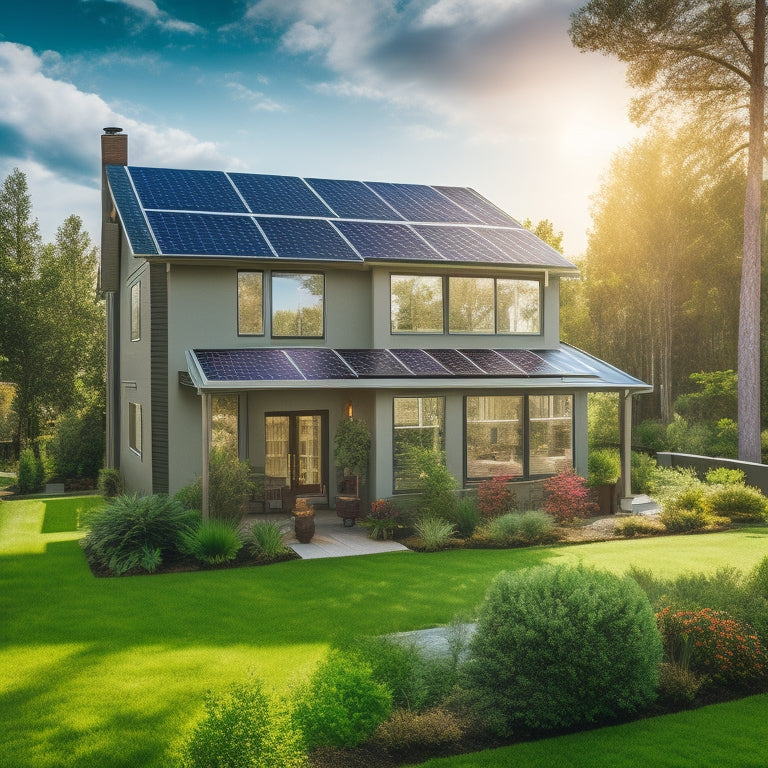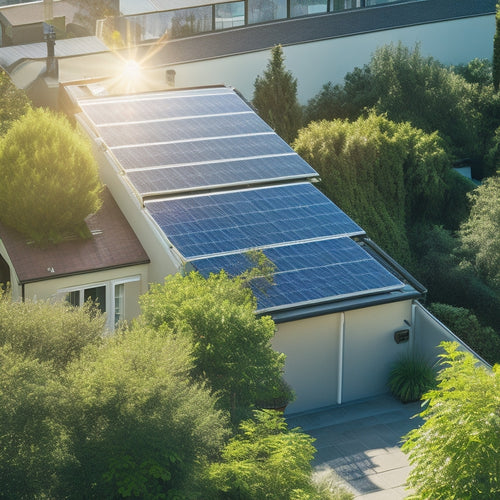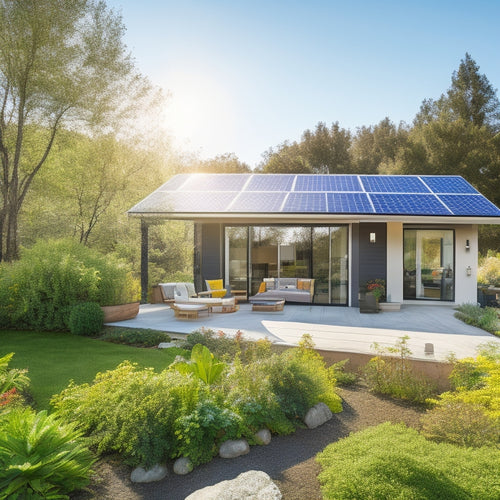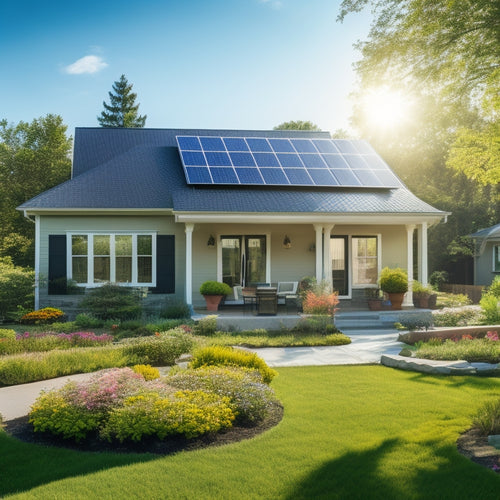
What Does Residential Solar Panel Installation Cost?
Share
Installing residential solar panels generally costs between $15,000 and $25,000, depending on factors like location and equipment choice. Solar panels cost between $0.50 to $1.50 per watt, and inverters go from $1,000 to $2,000. Labor and permitting fees make up about 10-20% of total costs, with hourly labor rates ranging from $50 to $120. Permits and inspections add another $100 to $500 to your budget. Costs for high-efficiency panels and reputable installers might be higher, but they guarantee better long-term savings and service. If you want to understand the full cost breakdown and potential savings, you're in the right place.
Key Takeaways
- The average cost for residential solar panel installation ranges between $15,000 and $25,000.
- Solar panels themselves cost between $0.50 to $1.50 per watt.
- Installation labor and permitting fees constitute around 10-20% of total expenses.
- High-efficiency panels and inverters may have higher upfront costs but offer long-term savings.
- Federal, state, and local incentives can significantly reduce the initial investment.
Average Cost Overview
https://www.youtube.com/watch?v=DSpNHtFWcn0
When considering residential solar panel installation, you can expect the average cost to range between $15,000 and $25,000 depending on the system size and location. Regional variations greatly impact your overall expenditure. For instance, areas with high sunlight exposure, like California and Arizona, often see lower installation costs due to economies of scale and local incentives. Conversely, regions with less sunlight or stricter regulations, such as the Pacific Northwest, may experience higher costs.
Beyond regional differences, energy savings play an important role in offsetting the initial investment. You're not just installing solar panels; you're investing in long-term energy efficiency. Over time, the savings on your electricity bills can be substantial. In high-sun regions, you might see a quicker return on investment, sometimes within five to seven years. In areas with less sunlight, the payoff period may extend, but the energy savings remain significant in the long run.
Understanding these cost factors empowers you to make informed decisions. By considering regional variations and potential energy savings, you can maximize both your financial and environmental benefits, setting yourself free from the unpredictability of traditional energy sources.
Equipment Prices
To better understand the financial commitment, let's break down the individual equipment prices involved in residential solar panel installation. The most significant component is, of course, the solar panels themselves. There are various panel types to take into account, such as monocrystalline, polycrystalline, and thin-film panels. Monocrystalline panels typically cost between $1 to $1.50 per watt, while polycrystalline panels range from $0.90 to $1 per watt. Thin-film panels are the least expensive, often priced at $0.50 to $1 per watt, but they're generally less efficient.
Next, you'll need a solar inverter, important for converting the direct current (DC) generated by the panels into alternating current (AC) used in your home. Solar inverters can cost between $1,000 to $2,000 for a standard residential unit. If you opt for a more advanced system with microinverters or power optimizers, expect the price to be higher.
Other essential equipment includes mounting hardware, which can range from $0.10 to $0.30 per watt, and the electrical wiring, typically costing around $1,000 to $2,000 depending on your system size and complexity.
Installation Fees
When considering installation fees, you'll need to account for labor and permitting costs, which can vary greatly by region.
Additionally, expenses for necessary equipment and materials, such as mounting hardware and wiring, add to the overall cost.
Labor and Permitting Costs
Labor and permitting costs, often constituting around 10-20% of the total installation expenses, are critical factors that should be taken into account when budgeting for residential solar panels. Labor costs can fluctuate based on your location, the complexity of your installation, and the prevailing labor market conditions. Labor shortages can drive up costs and cause delays, so securing a reliable installation team early in the planning process is crucial.
Permitting is another significant consideration. You'll need to obtain various permits from local authorities, which can include building permits, electrical permits, and possibly zoning approvals. Permit delays aren't uncommon and can extend your project timeline, affecting overall costs due to extended labor hours and potential rescheduling fees.
Understanding these costs will empower you to make more informed decisions and avoid unexpected financial burdens. By accounting for labor and permitting expenses from the start, you'll be better positioned to navigate the complexities of solar panel installation.
This proactive approach ensures that you not only achieve energy independence but also maintain control over your investment, freeing yourself from escalating traditional energy costs.
Equipment and Material Expenses
Equipment and material expenses, often representing a significant portion of the total installation cost, include solar panels, inverters, mounting systems, and other essential components. When considering these expenses, it's vital to focus on panel efficiency.
High-efficiency panels may cost more upfront, but they can generate more electricity in less space, potentially leading to greater long-term savings on your energy bills.
Inverters, which convert the direct current (DC) produced by panels into usable alternating current (AC), also vary in cost. Your choice between string inverters, microinverters, or power optimizers will affect both efficiency and price. String inverters are generally cheaper but mightn't handle shading issues as well as microinverters, which are more expensive but offer better performance in diverse conditions.
Mounting systems are another key expense. You'll need a reliable system that can withstand local weather conditions. This includes racks, rails, and any additional hardware required to secure the panels to your roof or ground setup.
Lastly, consider the warranty terms for all components. Longer warranties can provide peace of mind and potentially save you money on repairs or replacements down the line. Balancing initial costs against these factors will help you make an informed decision.
Labor Costs
Understanding labor costs is crucial, as they typically constitute a substantial portion of the overall expense for residential solar panel installation. You need to carefully evaluate hourly rates and contractor selection to maximize your investment's efficiency and effectiveness. Labor costs can vary greatly based on your location, the complexity of the installation, and the contractor's expertise.
Selecting the right contractor isn't just about finding the lowest hourly rates; it's about ensuring quality and reliability. Low rates might seem enticing, but experienced contractors often provide better long-term value through efficient and secure installations. Here's a comparative table to help you grasp the potential range of labor costs:
| Factor | Estimated Cost Range |
|---|---|
| Hourly Rates | $50 - $120 per hour |
| Basic Installation | $2,000 - $5,000 |
| Complex Installation | $5,000 - $10,000 |
| Additional Services | $500 - $1,500 |
| Total Labor Costs | $2,500 - $11,500 |
Permit and Inspection Fees
You'll need to budget for permit and inspection fees, which vary greatly based on your local government's regulations. These costs typically range from $100 to $500, covering the necessary permits and the inspection process to guarantee your installation meets safety standards.
Understanding these expenses upfront will help you plan your overall solar panel installation budget more accurately.
Local Government Charges
Securing a permit and passing the necessary inspections for residential solar panel installation can incur significant costs that vary depending on your local government's regulations. Zoning regulations may require you to submit detailed plans, and these plans must align with local codes. Any deviation might necessitate additional paperwork or even modifications to your installation, which can increase both time and costs.
Administrative fees are another consideration. These fees cover the cost of reviewing your application, processing permits, and conducting preliminary evaluations. Depending on your locality, these administrative fees can range from $100 to $500 or more. It's important to research your local government's specific requirements to avoid unexpected expenses.
Moreover, some jurisdictions impose fees based on the size and complexity of your solar panel system. Larger systems often face higher fees due to the increased effort required for evaluation and inspection. You might also encounter charges for environmental impact assessments if your system exceeds a particular size threshold.
Inspection Process Costs
Getting through the inspection process for residential solar panel installations can greatly impact your overall budget, with permit and inspection fees often adding up to several hundred dollars. During the initial consultation, you'll need to understand these costs, as they can vary substantially depending on your local jurisdiction's regulations and requirements.
Typically, you'll face fees for permits, which are necessary to make sure your installation meets local building codes and safety standards. These permits can range from $100 to $500. Additionally, a detailed assessment of your property might be required, which can further add to the costs.
Inspectors will review the installation both pre- and post-installation to ensure everything is compliant with local codes and utility company requirements. These inspection fees can tack on an extra $100 to $300.
Your solar installer usually handles the permit applications and inspection scheduling, but it's critical to factor these expenses into your overall budget. Understanding and planning for these costs during the initial consultation can help you avoid unexpected financial burdens.
Tax Incentives
Federal and state tax incentives can greatly reduce the overall cost of your residential solar panel installation. Federal credits like the Solar Investment Tax Credit (ITC) allow you to deduct 30% of the installation costs from your federal taxes. This can markedly lower your initial expenses. Additionally, many states offer rebates that further decrease your financial burden. State rebates vary, but they can range from a few hundred to several thousand dollars, depending on where you live.
Here's a quick comparison to illustrate the savings:
| Incentive Type | Potential Savings |
|---|---|
| Federal Credits | Up to 30% of installation cost |
| State Rebates | $500 - $5,000 |
| Combined Savings | Marked reduction in total cost |
Financing Options
Exploring the plethora of financing options available can greatly impact the affordability of your residential solar panel installation. Whether you're looking to own your system outright or prefer a more flexible arrangement, understanding your choices can make solar energy accessible without straining your finances.
For those aiming to own their solar panels, loan options are an effective way to spread out the cost. These loans often offer competitive interest rates and terms, allowing you to pay off the system over several years. Here are some common financing methods:
-
Solar Loans: Specifically designed for solar projects, offering lower interest rates and longer repayment terms.
-
Home Equity Loans: Utilize the equity in your home, often providing lower interest rates due to the secured nature of the loan.
-
Personal Loans: Unsecured loans with quicker approval processes but potentially higher interest rates.
-
Leasing Plans: Lease the solar system from a provider, often with little to no upfront cost, though you won't own the system.
-
Power Purchase Agreements (PPAs): Pay for the power generated rather than the system itself, with fixed rates potentially lower than your current utility costs.
Maintenance Expenses
Maintaining your solar panel system involves minimal costs, primarily for occasional inspections and cleaning to guarantee peak performance. Typically, you'll need to clean your panels once or twice a year to remove debris and dirt that can reduce efficiency. Establishing regular cleaning schedules is essential; you can either do it yourself or hire a professional service, which might cost between $100 to $300 per visit.
Inspections are another key component of maintenance. Annual or bi-annual inspections help identify potential issues early, preventing costly repairs down the line. A professional inspection usually runs around $150.
Additionally, many solar panel systems come with warranty coverage that lasts 20-25 years. These warranties often cover defective parts, installation issues, and even performance guarantees, mitigating your long-term financial risk.
Understanding these maintenance aspects empowers you to make informed decisions and maintain your system's efficiency. By adhering to recommended cleaning schedules and utilizing your warranty coverage, you ensure your solar panels remain in excellent condition with minimal out-of-pocket expenses.
This proactive approach not only protects your investment but also aligns with your goal of achieving energy independence and financial liberation.
Savings Over Time
By installing residential solar panels, you'll greatly reduce your electricity bills, offering substantial long-term savings.
Additionally, you can take advantage of tax incentives that further lower the overall cost of installation.
These financial benefits make solar panels a cost-effective investment over time.
Reduced Electricity Bills
Homeowners can greatly reduce their monthly electricity bills and achieve long-term savings by investing in residential solar panel installation. When you install solar panels, you're effectively generating your own electricity, which means you're less dependent on your utility company. This independence translates into significant energy savings and cost reductions over time.
Here's how you benefit:
-
Lower Monthly Bills: By producing your own electricity, you'll notice a dramatic drop in your monthly utility expenses.
-
Protection Against Rate Hikes: Utility rates can fluctuate, but with solar panels, you're less affected by increasing electricity costs.
-
Net Metering: Many areas offer net metering programs that allow you to sell excess electricity back to the grid, turning your home into a mini power station.
-
Increased Property Value: Homes with solar panels often sell at a premium, as buyers are willing to pay more for energy-efficient properties.
-
Return on Investment (ROI): The initial cost of installation can be recouped within a few years, after which the savings directly contribute to your financial freedom.
With residential solar panel installation, you're not just making an environmentally conscious choice – you're also setting yourself up for financial liberation through substantial energy savings and cost reductions.
Tax Incentives Benefits
Numerous tax incentives are available that can greatly reduce the initial costs of residential solar panel installation, making the investment even more attractive. The Federal Solar Investment Tax Credit (ITC) is one of the most significant benefits you can leverage. As of now, the ITC allows you to deduct 26% of the installation costs from your federal taxes. This means if your solar panel system costs $20,000, you can reduce your tax liability by $5,200, effectively lowering your out-of-pocket expense.
In addition to federal credits, many states offer their own rebates and incentives, which can further diminish your upfront costs. For instance, states like California and New York provide substantial rebates that can save you thousands. These state rebates are often stackable with federal credits, maximizing your total savings.
Over time, these incentives don't just make the initial investment more feasible; they also amplify your long-term financial benefits. With reduced initial costs and ongoing savings on utility bills, you effectively shorten the payback period for your solar panels.
Choosing a Provider
Selecting the right provider for your residential solar panel installation requires careful evaluation of their expertise, reliability, and pricing structures. You want to make sure that the investment is worthwhile and aligns with your expectations of performance and cost savings. A provider's reputation and customer reviews are essential components in making your decision. Dive deep into their history of installations and customer satisfaction to gauge their reliability.
Here are some key considerations when choosing the right provider:
-
Provider Reputation: Look for a company with a solid track record and positive feedback from past clients.
-
Customer Reviews: Read detailed reviews and testimonials to understand the experiences of other homeowners.
-
Certifications and Licenses: Confirm the provider holds the necessary certifications and licenses, indicating a standard of professionalism and adherence to industry standards.
-
Warranty and Support: Review the warranty terms and after-installation support, which are important for long-term maintenance and peace of mind.
-
Pricing Transparency: Make sure the pricing structure is transparent, with no hidden fees, and that it includes a detailed breakdown of costs.
Frequently Asked Questions
How Long Do Residential Solar Panels Typically Last?
Think of solar panels as a marathon runner. They typically last 25-30 years with minimal maintenance requirements. Expect efficiency degradation of about 0.5% per year, but their longevity guarantees you break free from rising energy costs.
Can Solar Panels Be Installed on Any Type of Roof?
Yes, you can install solar panels on various roof types, but roof compatibility is essential. Installation challenges include roof angle, material, and structural integrity. Consulting experts guarantees an efficient setup, maximizing performance and minimizing long-term costs.
What Happens to Solar Panels During Extreme Weather Conditions?
During extreme weather, solar panels showcase impressive storm durability and weather resistance. High-quality panels withstand hail, strong winds, and heavy snow. Investing in resilient panels guarantees long-term savings and energy independence, even in harsh conditions.
Are There Any Health Concerns Associated With Solar Panels?
You're concerned about health? Solar panels emit minimal electromagnetic radiation and rarely off-gas chemicals. They're considered safe, with benefits far outweighing risks. Liberation from fossil fuels is your path to a cleaner, healthier future.
How Do Solar Panels Impact Home Resale Value?
Ironically, adding solar panels might just increase your property value while also cutting energy costs. Energy savings appeal to buyers, leading to higher resale value. So, it's not just about being green; it's financially savvy too.
Related Posts
-

How Solar Panels Reduce Electricity Bills
Solar panels can drastically cut your electricity bills by utilizing sunlight to generate your own energy. This decre...
-

Green Home Improvements Using Solar Power
Investing in solar power alters your home into a sustainable haven while slashing energy costs. You can greatly reduc...
-

Affordable Solar Panels for Home Use
Affordable solar panels offer you a smart way to cut down on energy costs while promoting sustainability. With govern...


